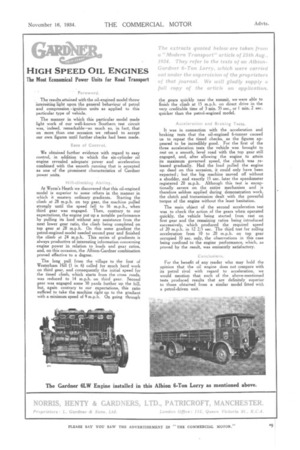HIGH SPEED OIL ENGINES
Page 63

If you've noticed an error in this article please click here to report it so we can fix it.
The Most Economical Power Units for Road Transport
Fares", . The results attained with the oil-engined model throw intereiiting light upon the general behaviour of petrol and compression ignition units as applied to this particular type of vehicle.
The manner in which this particular model made light work of our well-known Southern test circuit was, indeed, remarkable—so much so, in fact; that on more than one occasion we refused to accept our own figures until further checks had been made.
Ease of Control
We obtained further evidence with regard to easy control, in addition to which the six-cylinder oil engine revealed adequatepower and acceleration combined with the smooth running that is accepted as one or the piorninent Characteristics of Gardner power units.
Hill-climbing Ability.
At Worm's Heath we discovered that this oil-epgined model is superior to some others in the manner in which it masters ordinary gradients. Starting the climb at 28 m.p.h. on top gear, the machine pulled strongly until the speed fell to 16 m.p.h., when third gear was engaged. Then, contrary to our expectations, the engine put up a notable performance by pulling its load without any assistance from the next lower gear ratio, the climb being completed on top gear at 28. m.p.h. On this same gradient the petrol-engiried model needed second gear and finished the climb at 24 m.p.h. This series of gradients is always productive of interesting information concerning engine power in relation to loads and gear ratios, and, on this occasion, the Albion-Gardner combination proved effective to a degree.
The long pull from the village to the foot of Westerham Hill (1 in 6) called for much hard work on third gear, and consequently the initial speed for the timed climb, which starts from the cross roads, was reduced to 14 m.p.h. on third gear. Second -gear. was engaged some 50 yards further up the hill, but, again contrary to our expectations, this ratio sufficed to take the machine right up to the gradient with a minimum speed of 9 m.p.h. On going through
the gears quickly near the summit, we were able to finish the climb at 15 m.p.h. on direct drive in the very creditable time of 3 min. 35 sec., or 1 mm. 2 sec. quicker than the petrol-engined model.
Acceleration and Braking Tests.
It was in connection with the acceleration and braking tests that the oil-engined 6-tonner caused us to repeat the timed checks, as the figures appeared to be incredibly good. For the first of the three acceleration tests the vehicle was brought to rest on a smooth, level road with the top gear still engaged, and, after allowing the engine to attain its maximum governed speed, the clutch was released gradually. Had the load pulled the engine up dead on this occasion, it could only have been expected ; but the big machine moved off without a shudder, and exactly 15 sec. later the speedometer registered 20 m.p.h. Although this test is exceptionally severe on the entire mechanism and is therefore seldom applied during demonstration work, the clutch and transmission dealt with the powerful torque of the engine without the least hesitation.
The main object of the second acceleration test was to check the action of the gears when operated quickly, the vehicle being started from rest on first gear and the remaining ratios being introduced successively, which produced the required speed of 20 m.p.h. in 12 2/5 sec. The third test for rolling acceleration from 10 to 20 m.p.h. on top gear occupied 10 sec. only, the observations in this case being confined to the engine performance, which, as proved by the result, was eminently satisfactory.
Conclutdont, For the benefit of any reader who may hold the Opinion that the oil engine does not compare with its petrol rival with regard to acceleration, we would mention that each of the above-mentioned tests produced results that are definitely superior to those obtained from a similar model fitted with a petrol-driven unit.




















































































































































































